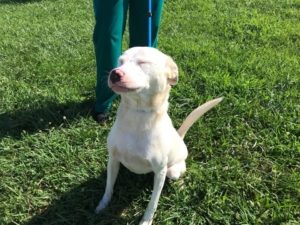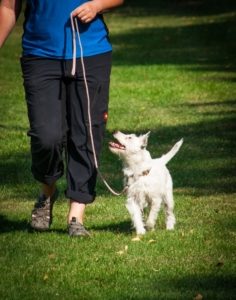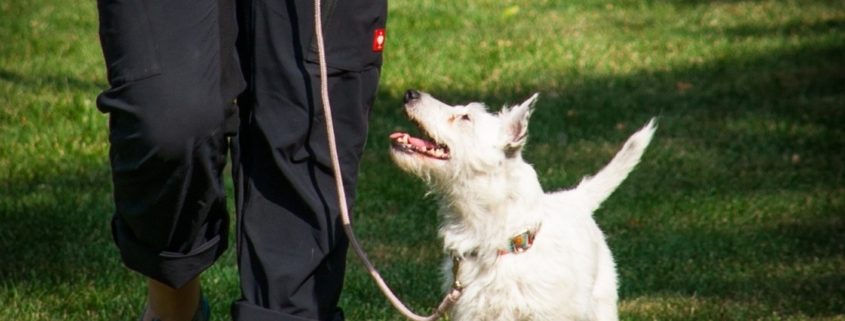Ask Crystal: Leash Walking Tips
Welcome to “Ask Crystal,” where you can ask your pet behavior questions! You can submit your question for Crystal at the bottom of the page!

Dear Crystal,
Thanks so much for your excellent class. My dog now walks nicely on leash except when we are approaching the dog park. I want to make her a therapy dog and part of the test requires being calm around other dogs and she just gets too excited when seeing another dog. Any suggestions?
Thanks,
Pulling Pup
Dear Pulling,
I am so glad to hear that you have been able to use the leash walking training we offer in class in the real world! It can often be difficult for students to transition from the class room to the extremely exciting and distracting world. We need to set up an alternative behavior for how we expect her to behave when she sees another dog. Luckily, since you have already attended a manners class you will be a leg up on some of the training.
I am a pretty big proponent of not allowing a dog to greet every dog it sees on leash. It sets up unrealistic expectations for the dog that she is going to be able to meet every dog she sees. When we tell her no that is not the case, it can cause frustration related behavior which can lead to barking and lunging. So rather, I would suggest that dogs are only allowed to greet on leash very rarely. I would also suggest that you teach a verbal cue which means the dog has your permission to go greet the other dog.
First, decide what behavior you would like her to be doing when another dog approaches. I would suggest that you have her hold a sit. What the testers for the therapy dog exam want is for your dog to be able to be calm and ignore another dog that is near it. If you have a friend with a mellow dog that can help you out that is going to be the best way to practice. I would suggest that you start out in an environment that the dog is more likely to be calm in. This could be in your front yard or somewhere around your neighborhood. A good exercise session beforehand will help the dog behave more calmly. You need to figure out what distance your dog needs to be away from the other dog in order to be calm and that is where you start. Place your dog in a sit position. Have the person start walking towards you with their dog calmly and slowly. If your dog gets up at any point, have the person stop and walk away several steps. Ask your dog to sit again and repeat. I want the dog to realize that her behavior has made the other dog go away. The only behavior that will work is continuing to sit. Be sure to feed her high value treats for continuing to sit. It is similar to teaching a stay in that you feed the treats at whatever delivery rate is necessary to keep the dog in the position. If you didn’t practice your sit stay a lot previously, I would suggest doing that at home as well. When your dog is able to hold the sit the entire time the other dog is approaching, you can then use your cue to go greet and allow her to go say hello. In this way, we can teach her what that cue means. You want to vary up whether you will allow her to say hello to the other dog while practicing. You don’t want to always allow her to greet since she won’t always be allowed to do that in every situation. Be sure to practice this with different dogs as well and then in more challenging environments.
 A couple other skills that are necessary to have in your toolbox are automatic check ins and a “find it” cue. We need to teach the dog to check in with us when they see a distraction so that we can tell them what to do next. One way you could do this is when your dog looks at something which could be a distraction like another dog say “yes” and treat. If we repeat this enough, the dog will begin to look back at you every time they see another dog. At that point, wait to feed them when they look back at you. When you are on walks if your dog looks back at you, tell her “steady” to have her walk next to you. The “find it” cue is a useful tool for those times when you don’t think your dog will be able to give you eye contact. As with all training, practice this at home in low distractions. Drop a treat on the ground in front of her and say “find it”, as she looks down, drop another treat and repeat “find it”. I try to drop the treats when the dog isn’t looking so the behavior isn’t dependent on my hand moving. This cue teaches a dog to sniff the ground on cue which is soothing to them. It also keeps them from looking up and seeing the other dog if you don’t want them to. “Find it” is a cue that is useful for a lot of different situations.
A couple other skills that are necessary to have in your toolbox are automatic check ins and a “find it” cue. We need to teach the dog to check in with us when they see a distraction so that we can tell them what to do next. One way you could do this is when your dog looks at something which could be a distraction like another dog say “yes” and treat. If we repeat this enough, the dog will begin to look back at you every time they see another dog. At that point, wait to feed them when they look back at you. When you are on walks if your dog looks back at you, tell her “steady” to have her walk next to you. The “find it” cue is a useful tool for those times when you don’t think your dog will be able to give you eye contact. As with all training, practice this at home in low distractions. Drop a treat on the ground in front of her and say “find it”, as she looks down, drop another treat and repeat “find it”. I try to drop the treats when the dog isn’t looking so the behavior isn’t dependent on my hand moving. This cue teaches a dog to sniff the ground on cue which is soothing to them. It also keeps them from looking up and seeing the other dog if you don’t want them to. “Find it” is a cue that is useful for a lot of different situations.
The other concern you have is her behavior while approaching the dog park. First, remember that self-control starts at home. At every step of the way to the park, wait for the dog to offer a polite sit before she gets anything. She should sit prior to the leash and harness being put on, sit and wait at the door, sit and wait at the car door. Then when you get to the park, sit and wait in the car so that she starts at a calm place.
You should go to the dog park and practice walking around calmly. You may want to walk her around the park without directly approaching the gate. You could take a zig zag approach. If she starts pulling, stop, get her back to your side and walk only if she is calm. Walk back and forth practicing walking calmly. If you need to get further away from the dog park, you might practice first in the parking lot. You need to start her at a distance where she can be calm. She does not get to go into the dog park until she can calmly walk up to the gate. You will probably have some practice sessions where she just goes to the park and doesn’t get to go into the dog park. That is ok, she may not get the concept immediately since she has been practicing pulling you into the park for so long. Once she is able to calmly walk to the gate, have her sit and wait so she practices self-control before entering. You may also want to periodically call her to you in the park and practice some sits and downs so she learns to be responsive in high distraction environments.
Luckily, a dog being excited about meeting other dogs is a good thing. We just need to teach her some skills about how to behave in the presence of other dogs. It will take some practice but if you can be clear and consistent about what you expect from her you will be able to get there. Good luck and happy training.
Until next time,
Crystal







